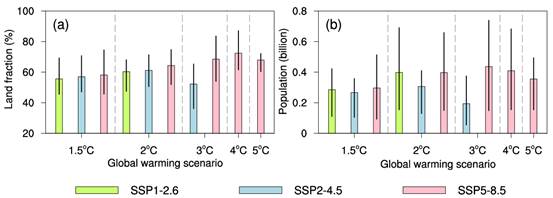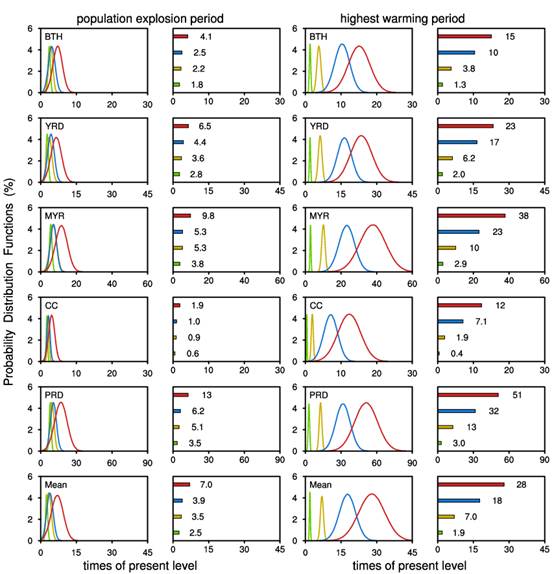为了应对全球变暖,《巴黎协定》提出将全球增温幅度控制在较工业革命之前2℃之内,并努力限制在1.5℃的目标。同时随着“双碳”目标的提出,未来中国的气候将如何改变,引起了科学界和决策者的高度关注。曾刚教授团队分别在Advances in Atmospheric Sciences和Environmental Research Letters发表文章,揭示了未来中国极端高温在不同排放情景下的变化,并结合人口数据对主要城市群的高温风险进行了定量预估。
研究利用最新的CMIP6数据集发现,当全球增暖达到1.5℃~5℃时,中国约有五至七成地区的增温幅度将高于全球平均水平,其中南方的极端高温事件增加相对更多,而北方则是高温事件的强度增幅更大。相对于2℃~5℃,将全球增暖控制在1.5℃将有利于避免36%~87%极端高温事件的增幅(Zhang et al., 2021, AAS)。结合人口数据,研究发现未来在高排放情景下(SSP3-7.0和SSP5-8.5),中国主要城市群(京津冀、长三角、珠三角、川渝地区和长江中游地区)的高温风险将是现代水平的数倍甚至数十倍,而在中低排放情景下(SSP1-2.6和SSP2-4.5),高温风险将会与目前的水平保持相似。预计在2041~2060年期间,五大城市群可能面临每年3至13个高温危险日(极易导致死亡风险);而如果高排放情景一直持续到21世纪末,届时的年均危险日将增至8~67天(Zhang et al., 2021, ERL)。该研究在发表后被Carbon Brief报道(https://www.carbonbrief.org/china-briefing-27-may-2021-crypto-crackdown-ets-launch-nears-energy-saving-data-centres)。

Fig.1. (a) The land fraction of China where warming is higher than the global average (%), and (b) the population of these regions (billion). Green, blue and red bars represent results of SSP1-2.6, SSP2-4.5, and SSP5-8.5. The perpendicular black lines at the top of the bars represent the variation between the 10th and 90th percentiles of the multi-model ensemble. From Zhang et al., 2021, AAS.

Fig.2. The probability density function (a, c) of heat risk changes from the present level at individual grids and regional averages (b, d) over the five CUAs under SSP1-2.6 (green), SSP2-4.5 (yellow), SSP3-7.0 (blue) and SSP5-8.5 (red) for the population explosion period (a, b) and the highest warming period (c, d). From Zhang et al., 2021, ERL.
论文信息:
Zhang, G., Zeng, G., Yang, X., & Jiang, Z. (2021). Future Changes in Extreme High Temperature over China at 1.5° C–5° C Global Warming Based on CMIP6 Simulations. Advances in Atmospheric Sciences, 38(2), 253-267. https://doi.org/10.1007/s00376-020-0182-8
Zhang, G., Zeng, G., Liang, X. Z., & Huang, C. (2021). Increasing heat risk in China’s urban agglomerations. Environmental Research Letters. 16, 064073.https://doi.org/10.1088/1748-9326/ac046e